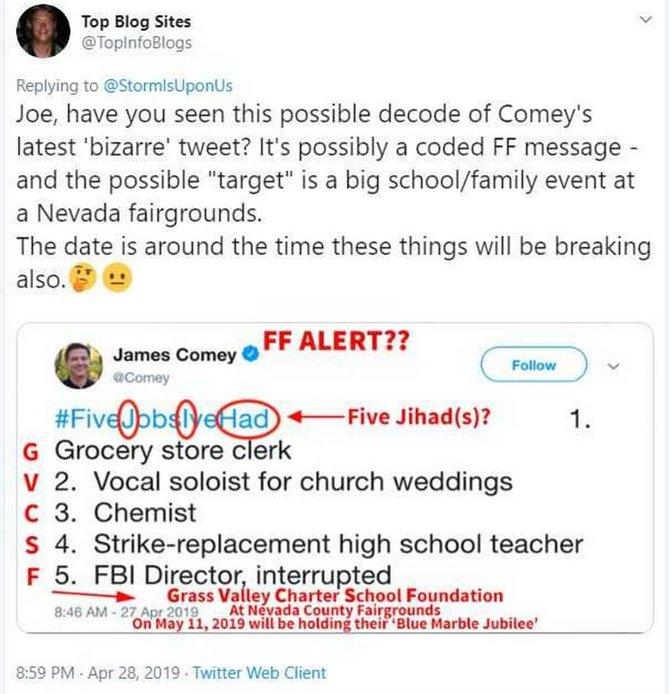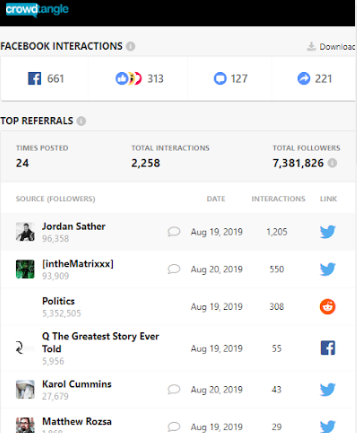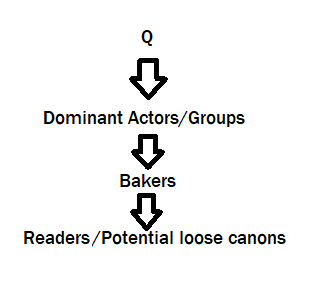
QAnon: The alt-right war machine and social media mobilization
QAnon is a pro-Trump conspiracy group born out of the recesses of imageboard website 4chan. It has a thriving online following and its main mission is to expose prominent left-wing political figures for being members of a worldwide cabal of Satan-worshipping pedophiles (Wong, 2020). This article delves into how prominent QAnon members utilize social media algorithms to mobilize its followers.
This article is supported by a diggit magazine audio podcast you can find below.
DIGGIT MAGAZINE AUDIO · DIGGIT MAGAZINE AUDIO - QANON EPISODE

The year is 2014, it is August 28th. Then-President of the United States, Barack Obama gives a live press conference on the US response to the Islamic State in Syria. Shortly after, controversy sparks on social media as politicians and civilians alike are shocked in both positive and negative ways by Obama’s "unpresidential" tan suit. Scandalous.
The year is 2017, it is October 6th. President Donald Trump meets with top military officials and states cryptically “You know what this represents? Maybe it’s the calm before the storm.” Media outlets are confused by the statement, as is the public, and in all fairness, so are the military officials surrounding Trump. No one to date can exactly explain what the "storm" is, but it's coming.
This contrast depicts the shift in political discourse in the public sphere between the two US presidencies. It paints a picture of the standards to which Barack Obama was held, and shows a drastic pivot as Donald Trump blatantly sows paranoia amongst the American people, unchallenged and unimpeded.
At the time, the "calm before the storm" statement resonates with an anonymous user on the infamous message board website 4chan. The user, under the alias "Q", announces the coming of a storm that will indict Hilary Clinton, Barack Obama and others of heinous crimes such as partaking in pedophilic sex rings (Zuckerman, 2019). As this anonymous Q enters the scene, their claims gain traction among conspiracy theorists that already believe in the "deep state" phenomenon. This new following is then dubbed "QAnon" after the anonymity of this new Q individual (Procházka & Blommaert, 2019).
With the power of social media, talk pertaining to QAnon spreads to other social networks like YouTube, Facebook, Twitter and Reddit. QAnon’s believers or followers are an active group of tech savvy individuals who know to maneuver through the back-ends of the online world.
The question at hand, however, is how QAnon conspiracy theorists utilize social media to their benefit. How have they managed to form a web that spans across several social media platforms? This article will dive into the world of QAnon conspiracy theorists and their tactics used in spreading the word of Q. Firstly, it will cover how QAnon operates and utilizes social media, issue-mapping the world of QAnon members. We will conclude with a case study on a prominent QAnon member and propagator, Jordan Sather.
Deciphering Q
QAnon exists in the online plane, while its theorists exist and conduct rallies and gatherings offline. Q seems to relish the anonymity that message board websites like 4chan and 8chan provide. This allows whoever it is behind these posts to speak with deliberate speculation. This section will discuss the concept of "baking" in the non-culinary sense: we will examine baking as a tactic that Q uses to incite the imagination of their active followers (Procházka & Blommaert, 2019).
The QAnon conspiracy theory has been compared to an alternate reality game, or ARG (Zuckerman, 2019), where the "real world" is the playing field and theorists are out on real-life quests to uncover deep-state crimes swept under the rug by cabal members, particularly George Soros. This leads individuals to feel part of the mission, as detectives, who find clues where none were meant to be found. Q can be imagined as a kind of narrator dropping "crumbs" or pieces of a puzzle in which it counts on it’s audience to piece together (Procházka & Blommaert, 2019). The individuals that try to piece the crumbs together are identified as "bakers" and they can be viewed as the actors that form the loaf of bread, or rather the bigger picture, from simple crumbs. These bakers take part in writing fanfiction. It is important to note that the QAnon member is not only a reader but also writer.
Devout believers in similar deep state conspiracies are known for treating such online crumbs as credible information and acting upon them offline.
Former FBI director James Comey took part in a viral challenge on Twitter called #fivejobsivehad, in which people listed 5 jobs they’ve had in their lifetime. Bakers investigated James Comey’s tweet for deeper meaning and deciphered the sentence "Five Jihad(s)" from the hashtag #fiveJobsIveHAD. They further identified that the first letters of each of his occupations spelt out "G-V-C-S-F". With this otherwise useless information, bakers came to the possible conclusion that Comey was dropping hints using acrostic spelling of a potential target. Grass Valley Charter School Foundation, a school in Nevada received a torrent of phone calls claiming that there was to be an imminent attach. The callers claimed to have a credible source, who was no other than a QAnon baker conjuring up false information (Zuckerman, 2019).

Devout believers in similar deep state conspiracies are known for treating such online crumbs as credible information and acting upon them offline. Other examples include the PizzaGate scandal in which a pizza place was incorrectly labeled a hub for child sex trafficking for US Democratic Party members. This led to an individual storming the pizzeria with an assault rifle to investigate the heinous crimes allegedly taking place there. Needless to say, there were none ("In Washington Pizzeria Attack, Fake News Brought Real Guns", 2020).
QAnon bakers utilize social media networks to mobilize their readers to find deeper meaning and in turn act in the offline world.(Zuckerman, 2019). In many cases such as the PizzaGate shooting, this can have dangerous consequences that put lives at risk. QAnon has loyal followers who truly believe the story it narrates and are not afraid to put themselves on the line.
Networks as a rally point
QAnon’s tendrils spread across the deep and dark ends of the internet, such as 8chan, but they also operate in the shallow more accessible end of the internet, on sites like Facebook, Twitter and Reddit. They have recently been banned from Reddit, however, for the allegation of inciting violence.
They have a presence on Facebook in the form of several similarly named QAnon groups. Example, QAnonPDX boasts 2.4 thousand followers. QAnon memes are shared and reacted to by the administrators and followers alike.

Crumbs from QAnon are also posted and bakers piece together their version of meaning amongst each other. For example, a post from Q lists acronyms followed by an American flag. A follower posts a response from an anonymous user who has "deciphered" these acronyms. The acronyms are mainly United States armed forces organizations; no further explanation is given. This a common factor in many QAnon breakthroughs, nothing fruitful comes out of them but at the same time Q’s erratic behavior entices followers to wait for more crumbs that might tie loose ends. Followers are led down an endless road of crumbs with no end in sight.

In this digital age, with large amounts of accessible data comes a new problem that QAnon capitalizes on; that is, the issue of credibility. We live in a post-truth era where facts carry less power than personal beliefs and emotive responses. This creates a breeding ground in a politically polarized society like that of the United States, in which QAnon can sell radical ideas to individuals who are steadfast on their political affiliations. These people are easy targets to be made into believers of the idea that Hilary Clinton and Obama are part of a child sex ring; that is, the idea becomes more palatable as it plays along political party lines (Foroughi, Gabriel, & Fotaki, 2019).
QAnon memes
QAnon Facebook pages and members on Twitter have QAnon-themed memes as a form of indexical ammunition. QAnon memes have a common denominator: Trump is depicted as the savior while characters such as Barack Obama, Hilary Clinton, Robert Mueller are depicted being imprisoned or as falling domino pieces (Varis & Blommaert, 2015).

Since QAnon’s foothold on Reddit was removed, 4chan has become the main origin of its meme-engine. It’s important to identify the limitations, purpose and value of these memes.
The limitations of such memes are enshrined in the bias behind their making and who they target (predominantly democrats).
The purpose of these memes is to further depict Donald Trump’s "the Storm is coming" prophecy that, any moment now, top democrats will be sent to prison for transgressions against the United States government.
These memes are of great value to the QAnon cause. Memes are a successful vector to spread ideas and propaganda, they are easily shared and do not require too much time to understand the main gist. They are also easy to make and, in most cases, don’t cost much.
Mapping the issue
For individuals that follow an anonymous entity, QAnon theorists ironically enjoy notoriety. Digital issue-mapping is a method for locating prominent networks and actors within an internet sphere. It is thus a vital method for identifying how QAnon groups digest news and react to it. Digital issue-mapping helps identify the following:
Prominent Actors: these individuals can sometimes be people on Twitter or Facebook groups with a large following. They add their spin on what they perceive as "mainstream media narratives". Their voices are noted as legitimate by their followers and thus have an impact on them.
Having identified the prominent actors, it is then possible to determine their alignment on issues, and how these dominant actors communicate about the issues at hand.
Jordan Sather

A prime example of a dominant actor is Jordan Sather. At the moment, he runs the YouTube channel "Destroying the Illusion" which boasts more than 200,000 followers. His YouTube page is an area for him to make daily reports on current events related to QAnon and other conspiracies. By doing so, he has created a network with his viewers and also aids a community on Facebook that share his ideas about "The Storm".
Algorithmic populism is a tool Sather utilizes to spread his take on the "misinformation" mainstream media reports about QAnon. This is done through the use of hashtags like #QAnon and #TheGreatAwakening. Utilizing issue-mapping software CrowdTangle, we can paint a picture of Sather's activity and uptake online. On many occasions, he is at the top of the leaderboards in interactions. This suggests that his reach is quite wide, and he has an active and virulent base of supporters. Interactions are not only positive though. Twitter is a popular battlefield of ideas, and individuals with opposing views also interact with him. He is master at communicating his stance on an issue by staying engaged with daily news and releasing videos on a regular basis.

Commitment-wise, Jordan Sather is fully dedicated to the QAnon cause. In a video he claims he first discovered QAnon on Twitter and has subscribed to their ideas ever since. Like many QAnon members, Sather believes in an idea of a great awakening, and the notion that a large truth is being hidden from the public. Sather and others have a self-inflicted onus to awaken the blind masses. The Matrix’s red pill is a standard metaphor for QAnon members as they feel like they have taken the route of resistance and awakening (Procházka & Blommaert, 2019). This feeling is emboldened by Sather with each video he puts out about new breakthroughs and clues. This urge that drives QAnon members to self-investigation and baking is a by-product of the existing power structure within the followers of Q.

All in all, QAnon and its followers pose a real threat to the United States’ security. The ability of QAnon members to take actions into their own hands and do harm is becoming self-evident by the day. This goes to show how social media allows for an entity like QAnon to choreograph its audience into taking action in the offline world. QAnon uses social media as a rally point where it can recruit and instill a false sense of "wokeness" in new members. Memes are weaponized to carry hate speech and push forward an agenda based on unchecked false truths. QAnon members like Jordan Sather accelerate the descent from skeptic to extremist with the use of indoctrination updates and the idea that individuals must be "awoken". QAnon knows how to play the social media game effectively and is evidently a force not to be underestimated.
References
Wong, J. (2020). Down the rabbit hole: how QAnon conspiracies thrive on Facebook. Retrieved 28 June 2020, from https://www.theguardian.com/technology/2020/jun/25/qanon-facebook-conspi...
Zuckerman, E. (2019). QAnon and the Emergence of the Unreal. Journal of Design and Science, (6). https://doi.org/10.21428/7808da6b.6b8a82b9
Procházka, Ondřej & Blommaert, Jan. (2019). Ergoic framing in New Right online groups: Q, the MAGA kid, and the Deep State theory.
Varis, P. & Blommaert, J. (2015). Convivality and collectives on social media: Virality, memes and new social structures. Multilingual Margins, 2(1).
"In Washington Pizzeria Attack, Fake News Brought Real Guns." (2020). Retrieved 10 January 2020, from https://www.nytimes.com/2016/12/05/business/media/comet-ping-pong-pizza-...
Foroughi, H., Gabriel, Y., & Fotaki, M. (2019). Leadership in a post-truth era: A new narrative disorder? Leadership, 15(2), 135–151. https://doi.org/10.1177/1742715019835369
"Reddit Bans QAnon Subreddits for Inciting ‘Violence’." (2020). Retrieved 10 January 2020, from https://www.thedailybeast.com/reddit-bans-qanon-subreddits-for-inciting-...
"I understand the temptation to dismiss QAnon. Here’s why we can’t." (2020). Retrieved 10 January 2020, from https://www.washingtonpost.com/opinions/2019/08/07/qanon-isnt-just-consp...
"#QAnon, the scarily popular pro-Trump conspiracy theory, explained." (2020). Retrieved 10 January 2020, from https://www.vox.com/policy-and-politics/2018/8/1/17253444/qanon-trump-co...